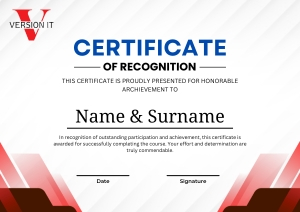DevOps is a culture, process, and tools framework that defines modern software delivery. It is a combination of Development and Operations that contributes to an organization’s ability to deliver applications and services more quickly. It is closely associated with the techniques of Continuous Delivery, Continuous Integration, and Continuous Deployment. It enables businesses to better serve their customers and compete more effectively in the market.
DevOps has the potential to improve the quality of software deployments. It produces a much higher quality product by developing and testing it more frequently. It produces a much higher quality product by developing and testing it more frequently. The amount of collaboration that Agile brings to the table is one of the best DevOps benefits.
Home > Courses > Trending Courses > DevOps Course
DevOps Training in
Hyderabad
DevOps Training in Hyderabad by Version IT provides comprehensive training to software engineers and IT students. DevOps helps IT professionals build a solid career in this rapidly growing field. DevOps training also enhances your skills and plays a vital role in advancing your career.
15 Modules
with Certifications
Certificate
After Completion
English
Language
What is DevOps?
Who Can Enroll Devops Training?
- Freshers looking for IT Career
- Security engineers
- Application developers
- Integration specialists
- IT professionals
- Software testers
- System administrators
- Solution architects
Why should everyone learn DevOps Course?
DevOps helps to strengthen teamwork and eliminate any gaps between the development and operations teams. As a result, many businesses are investing in this technology in order to complete the practices in a simple and reliable manner. The DevOps culture allows for faster problem resolution and more secure operating environments.
Some important DevOps training outcomes are listed below:
- Completing this DevOps training can lead to several well-paying jobs all over the world, as DevOps is in high demand right now.
- DevOps Course will facilitate IT professionals and Software Engineers in establishing a strong career as a DevOps Engineer in this rapidly growing field.
- By aligning business and IT, DevOps insists on continuous improvement. It aspires to reduce the reaction cycle and delivery loops, which increases customer satisfaction.
- DevOps primarily reduces problem complexity, provides a quicker fix, and creates a more secure operating environment.
- Since you are familiar with the many tools and technologies used for development, testing, and deployment, your value to the firm increases as a result of this DevOps Course.
Version IT is one of the top leading Institutes for DevOps training in Hyderabad and provides both online and classroom training. The top DevOps trainers, instructors, coaches, and consultants are offered by Version IT, and they have a cumulative 15 years of experience in the IT industry.
Topics You will Learn
ANT
- Overview of the Build Procedure and Build
- Ant installation and setup
- Terms and topics related to ants
- Collaborating with Ant
- Ant Activities
- Using Ant tasks to automate your build and testing
- Automating deployment using Ant
- Designing Unique Ant jobs
Curriculum for DevOps Training in Hyderabad
- Definition of DevOps; Activities related to Development and Operations
- DevOps Scope
- Instruments for the DevOps process
- DevOps engineers’ roles and responsibilities
Summary of
- IAAS
- PAAS
- SAE
DevOps in virtualization and cloud computing
Using containership in the DevOps paradigm
A DevOps career
GIT
- An overview of the version control system?
- The distinction between distributed and central version control
- Downloading and installing the Git programme along with its settings.
- Git Framework
- Change the flow with Git
- Concerning bitbucket
- Building repositories on Bitbucket and GitHub and engaging in games on
- Exercise: Carrying out a local Git pipeline
- Exercise: Utilising a distant (local) repository
- Git diff, git tags, and git branching strategy
- Comparing modifications
- Git stowing modifications
- Using git reset to reset changes
- Eliminating modifications from the staging area and working tree for monitored files
- Getting files out of the past
- Revert commits
- Rebasing and merging branches, as well as resolving merge conflicts
- Using the interactive rebase to edit history
- Applying the command “git cherry-pick”
- Explain alias
- Transitioning from SVN
Maven
- Overview of Apache Maven
- Setting Up and Utilising Apache Maven
- How to Begin Using Maven
- Phonology and POM organisation
- Developing Archetypes (Web, Multi-Module, and Standard Java Projects)
- Frequently Used Plugins
- Creating Maven Plugins
- Manage Repositories
- Release Administration
- Maven integration with other IDEs or Eclipse
- Integration with Sonarqube
- Artifactory and Nexus integration
- Implementation on
SonarQube
- An overview of code coverage, code analysis, and code review
- SonarQube download, installation, and configuration
- Values for quality gates and thresholds
- Concerning the code rule
- Tailor and generate a new code rule
- Integrating Sonar with Jenkins & Maven.
Nexus SonaType & Jfrog Artifactory
- Explaining the Binary Repository and Its Necessity
- Install, configure, and download the Nexus and Factory tools.
- How to set up a snapshot and release
- How to design and customise
- Integration of Nexus and Artifactory repositories with Maven
Ansible
- An overview of infrastructure management and configuration management
An overview of Ansible - Installation, setup, and download
- Regarding inventory with the host
- Concerning Ansible Playbooks
- Creating new server instances and dynamic inventory on AWS.
- Setting up web servers
- Using Ansible for application deployment
- About the roles and provisioners in Ansible.
- Concerning Ansible
- An overview of infrastructure management and configuration management
An overview of Ansible - Installation, setup, and download
- Regarding inventory with the host
- Concerning Ansible Playbooks
- Creating new server instances and dynamic inventory on AWS.
- Setting up web servers
- Using Ansible for application deployment
- About the roles and provisioners in Ansible
- Concerning Ansible
ELK
- An overview of ELK
- Installing and setting up the file beat
- Setting up and configuring Elastic Search
- Kibana installation and setup
- Examining and Resolving Issues
Linux
- Unix’s introduction
- Setup
- Boot process and kernel configuration
- The hierarchy of file systems
- Simple instructions
- Software administration
- Group and User management
- Handling partitions and file systems
- SELINUX (FUNDAMENTAL)
- Configuring and troubleshooting networks
- Fire Protection Systems
- Web server
Script Shell
The release of UNIX Shell
Shell output and input
Variables
Handlers
Code with Conditions
Loops
Text entry
Jenkins
- An overview of continuous delivery, continuous deployment, and continuous integration (CI/CD/CD)
- The Past of Jenkins
- Installing and configuring Jenkins using different approaches.
- Establish Security
- Version Control and Email
- Master/slave arrangements
- Establishing, setting up, and executing a Jenkins task
- Manually and automatically completing tasks using a timetable and poll
- Every feature and configuration under MANAGE JENKINS
- Keeping an eye on outside jobs
- Developing pipelines for builds and deploys as a Jenkins pipeline
- Slave and master
AWS (Amazon Web Services)
- Overview of Cloud Computing
- AWS Management Interface
- Amazon Architecture
- Establishing the
- Amazon Account
- Amazon EBS and EC2
- S3 is an AWS storage service
- Cloud Watch on Amazon
- ELB
- AutoScaling
- IAM
- RDS
- Dynamo Database
- AWS Cloud Front
- Cloud Formation
- Social Network
- VPC
- Route53
Docke
- An overview of both virtual and conventional server architecture
- An overview of Docker’s architecture and the underlying
- Concerning Docker
- Downloading and installing Docker
- Regarding pictures, containers, and experiment with
- Docker machine (Dock).
- Docker volumes
- Docker networking
- Binding of Docker ports
- Docker file or build.
- Docker creates
- Docker swarm
- Dockerizing the programmes
Kubernates
- Installing and downloading Kubernetes
- Developing tasks, pods, deployments, and services for Kubernetes.
- Volumes and persistent storage in storage
- Input and load balancing
Nagios
- Overview of Nagios
- Setting up Nagios Server
- Integrating Distant Hosts
- Examining and Resolving Issues
Let Your Certificates Speak

- With a background in collaborative processes, continuous integration, and delivery, the individual is a certified DevOps professional.
- Certificates are globally recognized & they upgrade your programming profile.
- Certificates are generated after the completion of course.
All You Need to Start this DevOps Course
- Development and operations teams must work together in DevOps.
- To bridge the gap and execute successful DevOps methods, a thorough grasp of both software development processes and IT operations is required.
Testimonials



Still Having Doubts?
- History of DevOps
- Dev and Ops
- DevOps definitions
- DevOps and Software Development Life Cycle
- DevOps main objectives
- Infrastructure As A Code
- Overview of Chef
- Common Chef Terminology (Server, Workstation, Client, Repository etc.)
- Servers and Nodes
- Chef Configuration Concepts
- Workstation Setup
- How to configure knife
- Execute some commands to test connection between knife and workstation
- Introduction
- What is Vagrant
- Uses of Vagrant in an environment
- Installation and Configuration
- How to install Vagrant in Windows and Linux
- Configure Vagrant
- Provisioning with Vagrant
- GIT REPOSITORY
- What is a version control system?
- What is a distributed version control system?
- Installation
- Different levels of Git configuration
- The process of staging and committing
- The details of the commit objects


